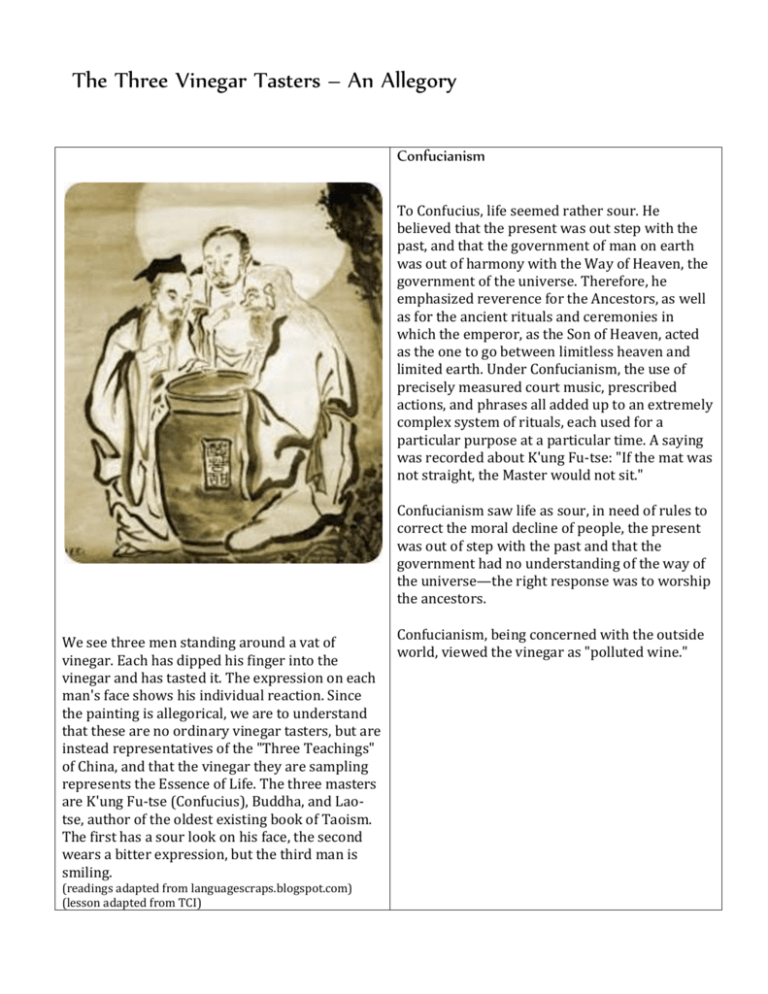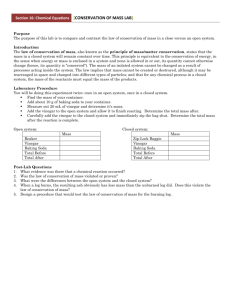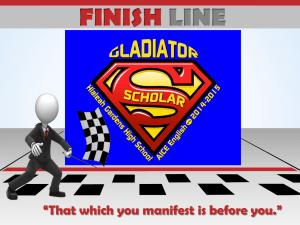Three Vinegar Tasters: Confucianism, Buddhism, Taoism
advertisement

The Three Vinegar Tasters – An Allegory Confucianism To Confucius, life seemed rather sour. He believed that the present was out step with the past, and that the government of man on earth was out of harmony with the Way of Heaven, the government of the universe. Therefore, he emphasized reverence for the Ancestors, as well as for the ancient rituals and ceremonies in which the emperor, as the Son of Heaven, acted as the one to go between limitless heaven and limited earth. Under Confucianism, the use of precisely measured court music, prescribed actions, and phrases all added up to an extremely complex system of rituals, each used for a particular purpose at a particular time. A saying was recorded about K'ung Fu-tse: "If the mat was not straight, the Master would not sit." Confucianism saw life as sour, in need of rules to correct the moral decline of people, the present was out of step with the past and that the government had no understanding of the way of the universe—the right response was to worship the ancestors. We see three men standing around a vat of vinegar. Each has dipped his finger into the vinegar and has tasted it. The expression on each man's face shows his individual reaction. Since the painting is allegorical, we are to understand that these are no ordinary vinegar tasters, but are instead representatives of the "Three Teachings" of China, and that the vinegar they are sampling represents the Essence of Life. The three masters are K'ung Fu-tse (Confucius), Buddha, and Laotse, author of the oldest existing book of Taoism. The first has a sour look on his face, the second wears a bitter expression, but the third man is smiling. (readings adapted from languagescraps.blogspot.com) (lesson adapted from TCI) Confucianism, being concerned with the outside world, viewed the vinegar as "polluted wine." Buddhism Daoism Buddhism was founded by a man named Siddhartha Gautama, who claimed to be enlightened when he was thirty-five years old. Siddhartha lived a very sheltered and extravagant life growing up. As he neared his thirties it is said that he became aware of all the ugliness in the world, this prompted him to leave his home in search of enlightenment. At the start of his travels Siddhartha became a beggar and studied philosophy, however, his studies did not lead him to the answers that he sought. He then lived a life of poverty for six years; this also failed to bring him enlightenment. At this point Siddhartha decided to meditate until he found the enlightenment that he was searching for. After much meditation he became enlightened and was henceforth known as Buddha which means 'awakened one'. To Lao-tse (LAOdsuh), the harmony that naturally existed between heaven and earth from the very beginning could be found by anyone at any time, but not by following the rules of the Confucianists. As he stated in his Tao To Ching (DAO DEH JEENG), the "Tao Virtue Book," earth was in essence a reflection of heaven, run by the same laws - not by the laws of men. These laws affected not only the spinning of distant planets, but the activities of the birds in the forest and the fish in the sea. According to Lao-tse, the more man interfered with the natural laws of the universe, the more difficult it would be to find harmony. The more forcing, the more trouble. Whether heavy or light, wet or dry, fast or slow, everything had its own nature already within it, which could not be violated without causing difficulties. When abstract and arbitrary rules were imposed from the outside, struggle was inevitable. Only then did life become sour. To Buddha, the second figure in the painting, life on earth was bitter, filled with attachments and desires that led to suffering. The world was seen as a setter of traps, a generator of illusions, a revolving wheel of pain for all creatures. In order to find peace, the Buddhist considered it necessary to rise above or transcend "the world of dust" and reach Nirvana, literally a state of "no wind." Although the essentially optimistic attitude of the Chinese altered Buddhism considerably after it was brought in from its native India, the devout Buddhist often saw the way to Nirvana interrupted all the same by the bitter wind of everyday existence. One interpretation of this picture is that Buddhism, being concerned with the self, viewed the vinegar as a polluter of the taster's body and soul due to its extreme flavor. Another interpretation for the image is that Buddhism reports the facts are as they are, that vinegar is vinegar and isn't naturally sweet on the tongue. Trying to make it sweet is ignoring what it is, pretending it is sweet is denying what it is. To Lao-tse, the world was not a setter of traps but a teacher of valuable lessons. Its lessons needed to be learned, just as its laws needed to be followed; then all would go well. Rather than turn away from "the world of dust," Lao-tse advised others to "join the dust of the world." What he saw operating behind everything in heaven and earth he called Tao (DAO), "the Way." In the vinegar tasters picture Laozi's (Lao Tzu) expression is sweet because of how the religious teachings of Taoism view the world. Every natural thing is intrinsically good as long as it remains true to its nature. This perspective allows Laozi to experience the taste of vinegar without judging it. "Ah this," he might be thinking, "this is vinegar!" From such a perspective, the taste doesn't need to be sweet, sour, bitter or bland. It is simply the taste of vinegar. By openly experiencing vinegar as vinegar, Laozi acknowledges and participates in the harmony of nature. As this is the very goal of Taoism, whatever the taste of vinegar, the experience is good. Each of the quotes below are from one of the three founders of Chinese religion. Read each quote with your partner, share what you think the quote is saying and write that down in the box below each quote. Then try to identify the speaker of the quote: Lao-tse, Confucius, or Buddha. Quote A: “Like a spider caught in its own web is a person driven by fierce cravings. Break out of the web, and turn away from the world of sensory pleasure and sorrow.” What does this statement mean and who would have said it? Quote B: “If a ruler himself is upright (honest), all will go well without orders. But if he himself is not upright, even though he gives orders they will not be obeyed.” What does this statement mean and who would have said it Quote C: Highest good is like water. Because water excels in benefitting the myriad (numerous) creatures without contending (having conflict) with them and settles where none would like to be, it comes close to the Way.” What does this statement mean and who would have said it? Quote D: “The mind is flighty, and hard to grasp: the mind pursues all its desires. To tame the mind is great goodness. Subdue (bring under control) the mind and know tranquility (calmness). What does this statement mean and who would have said it? Quote E: “the more laws and edicts (official rules) are imposed, the more thieves and bandits there will be.” What does this statement mean and who would have said it? Quote F: “Be respectful at home, serious at work, faithful in human relations. Even if you go to uncivilized areas, these virtues (good qualities) are not to be abandoned: What does this statement mean and who would have said it? Quote G: “Life is a journey, death is a return to the earth, the universe is like an inn, the passing years are like dust.” What does this statement mean and who would have said it? Quote H: “The sage (wise person), because he does nothing, never ruins anything; and, because he does not lay hold of anything, loses nothing.” What does this statement mean and who would have said it?






